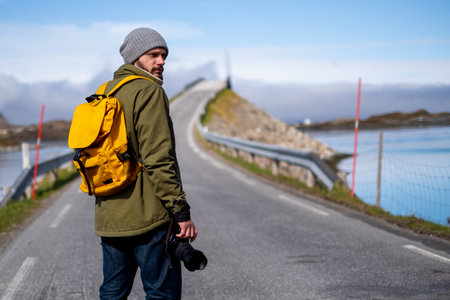Choosing the Right Route Across Britain
When planning a British cycle camping tour, your choice of route is the bedrock upon which your entire adventure will rest. The UK offers a vast network of cycle routes that range from world-renowned paths to hidden byways, each with its own character and challenges. Whether you’re drawn to the rolling hills of the Cotswolds, the rugged wilds of the Scottish Highlands, or the coastal beauty of Wales, it’s essential to match your route to your experience level and interests.
England: Classic Paths and Undiscovered Lanes
The National Cycle Network provides a backbone for long-distance touring in England. Favourites like the Coast to Coast (C2C) route deliver sweeping views across northern landscapes, while quieter options such as the Somerset Levels or the Norfolk Broads reveal the country’s more tranquil side. Don’t underestimate England’s weather—pack for rain even in high summer, and always factor in short daylight hours if riding outside peak months.
Scotland: Wild Frontiers and Remote Beauty
For those who yearn for solitude and raw scenery, Scotland’s routes such as the North Coast 500 or Hebridean Way are legendary. Here, you’ll contend with unpredictable weather, steep gradients, and remote stretches where services are few and far between. Prepare well—carry extra provisions and ensure your kit can handle rough terrain and sudden downpours.
Wales: Mountain Passes and Coastal Trails
Cycling in Wales means tackling climbs through Snowdonia or tracing dramatic coastal routes along Pembrokeshire. The landscape demands respect; challenging ascents are rewarded with panoramic views and a palpable sense of achievement. Be mindful of rapidly changing weather—Welsh storms can sweep in without warning, so pack accordingly.
Local Insight: Tapping into Regional Highlights
Each region brims with local flavour—think village pubs, historic landmarks, and unique wildlife. Take time to research highlights along your chosen path, whether it’s a detour to Hadrian’s Wall or an overnight stay in a bothy in the Highlands. In Britain, planning isn’t just about logistics; it’s about weaving together culture, nature, and resilience into one unforgettable journey.
Understanding UK Cycle and Camping Laws
If you’re planning a cycle camping tour across Britain, it’s essential to get your head around the rules that govern where you can ride, pitch up, and how to behave on the trails. The UK’s patchwork of rights of way, strict wild camping laws, and longstanding countryside etiquette set the ground rules for every cyclist venturing into the wild. Here’s what you need to know before rolling out.
Rights of Way: Where You Can Ride
The British countryside is criss-crossed with public rights of way, but not all are open to cyclists. It pays to understand the distinctions:
| Type of Path | Cycling Permitted? | Notes |
|---|---|---|
| Public Footpath | No | For walkers only; cycling here is technically trespass. |
| Bridleway | Yes | Open to cyclists and horse riders; expect mixed use. |
| Byway Open to All Traffic (BOAT) | Yes | Also used by vehicles—expect rough surfaces. |
| Restricted Byway | Yes | No motor vehicles, but cycling is fine. |
| National Cycle Network Routes | Yes | Purpose-built for cycling; often traffic-free. |
Wild Camping: Know Before You Pitch
Unlike Scotland, where wild camping is largely permitted under the Outdoor Access Code, most of England, Wales, and Northern Ireland operates on a strict “no wild camping” policy unless you have landowner permission. Breaching this can result in being moved on or even fined. Dartmoor National Park offers some exceptions—always check local bylaws.
| Country/Area | Wild Camping Rules |
|---|---|
| Scotland | Permitted under Outdoor Access Code (with responsibility) |
| Dartmoor (England) | Some areas permit wild camping—follow park guidance |
| Rest of England & Wales | Generally prohibited without explicit landowner consent |
| Northern Ireland | No general right—seek landowner permission first |
Countryside Etiquette: Leave No Trace and Respect Others
The unwritten code in the British outdoors is simple: leave no trace, respect local communities, and keep noise down. Close gates behind you, don’t block tracks when stopping for a brew-up, and always take litter home. Cyclists should slow down for walkers and horses—ring your bell well in advance and greet others with a friendly nod or “cheers.” If you’re unsure about pitching up, always ask nearby landowners or farmers; a polite word can go a long way in rural Britain.
Summary Checklist: Riding and Camping Legally in Britain
- Stick to bridleways, byways, and cycle routes—avoid footpaths unless specifically allowed.
- If wild camping outside Scotland/Dartmoor, always seek permission first.
- Follow ‘leave no trace’ principles: pack out all rubbish and avoid damage to the landscape.
- Treat locals with respect—courtesy opens doors (and sometimes fields) on your journey.
- Check local signage for any seasonal restrictions or special access rules before heading off-road.
This groundwork will keep your adventure legal, respectful, and hassle-free—letting you focus on the ride rather than worrying about run-ins with gamekeepers or grumpy farmers.

3. Navigating the British Weather and Terrain
When planning a cycle camping tour across the UK, one of your biggest challenges will be dealing with the famously unpredictable British weather. Rain can fall at any time of year, even in summer, so always pack waterproofs and quick-drying kit. A sturdy, reliable rain jacket and breathable layers are essential—avoid cotton, which will leave you cold and clammy. Don’t forget full-fingered gloves and overshoes to keep extremities warm during those early morning starts or sudden downpours.
Understanding local geography is equally important for a successful trip. The UK boasts a vast array of landscapes—from the rolling hills of the Cotswolds to the rugged climbs of the Lake District and Scottish Highlands. Study your route in advance using Ordnance Survey maps or digital navigation tools like Komoot or OS Maps. Pay close attention to elevation profiles; what looks like a short hop on paper can be an energy-sapping slog if you’re not prepared for constant ascents and descents.
Plan your travel with safety and efficiency in mind. Rural lanes can be narrow and winding, while urban areas may have heavy traffic or confusing cycle infrastructure. Always carry front and rear lights, even in summer—the weather can close in quickly, reducing visibility. Have high-visibility kit handy when riding on country roads or in poor conditions. It’s wise to let someone know your daily route and expected arrival points, especially if wild camping or venturing into remote areas.
Don’t underestimate the value of local knowledge: chat with other cyclists at campsites or cafes for real-time tips about roadworks, detours, or hidden gems along your journey. With careful planning and respect for the elements, you’ll keep your tour both safe and memorable—no matter what surprises the British climate throws your way.
4. Essential Kit for British Cycle Camping
If you’re gearing up for a cycle camping tour across Britain, your kit list needs to account for the ever-changeable UK weather, varied terrain, and rural isolation. Here’s a no-nonsense breakdown of what you’ll need to survive—and thrive—on the road.
Tents & Sleeping Gear
The British climate is notoriously unpredictable. Your tent should be waterproof, quick to pitch, and sturdy in strong winds—look for something with a hydrostatic head of at least 3000mm. As for sleeping arrangements, a three-season sleeping bag is essential even in summer, paired with an insulated mat for comfort and warmth on damp ground.
| Item | Recommended Spec | UK-Specific Tip |
|---|---|---|
| Tent | Lightweight, double-skinned, 3000mm+ hydrostatic head | Pitches inner and outer together to avoid wetting your sleeping area |
| Sleeping Bag | Three-season (comfort rating 0°C) | Synthetic fill dries faster than down in wet conditions |
| Sleeping Mat | Insulated, inflatable or foam | Check for puncture repair kit included |
Wet Weather Clothing
No British tour is complete without rain. Waterproofs are non-negotiable: invest in a breathable jacket and over-trousers. Don’t skimp on merino or synthetic base layers—they wick moisture and keep you warm when soaked. Always pack full-fingered gloves and waterproof socks; cold hands and feet will end a ride fast.
Tools & Bike Spares for the UK Roads
British roads can be rough, especially on B-roads and country lanes. Your tool kit must cover the basics: multi-tool, tyre levers, puncture repair kit, chain breaker, spare tubes (the correct valve type for your rims), and a portable pump. For the UK specifically, carry:
- Spare brake pads (especially for disc brakes—mud eats through them quickly)
- A spare derailleur hanger (often hard to source outside major towns)
- A robust lock—cycle theft is common in urban areas
UK-Specific Bike Spares Table
| Part | Why You Need It in the UK |
|---|---|
| Mudguards (Fenders) | Makes wet rides bearable; keeps spray off you and your kit |
| Dynamo lights/Good quality lights | Narrow country lanes can get pitch dark; required by law after dusk |
Final Survival Tips
Always have cash for rural shops or campsites that don’t accept cards, and download offline maps as phone signal can be patchy. With this kit packed tight, you’ll be ready to take on whatever the British weather—or countryside—throws at you.
5. Honest Survival Tips and Local Know-how
If you want to thrive on a British cycle camping tour, forget the romanticised travel brochures—real survival comes down to grit, smart planning, and a dose of local knowledge. Here’s what the guidebooks don’t tell you.
Dealing with Midges: The Tiny Terrors
Scotland and parts of the Lake District are notorious for midges—minuscule biting insects that can ruin an otherwise idyllic evening at camp. Don’t bother with wishful thinking; pack a reliable midge repellent (look for ones with DEET or picaridin) and consider a head net if you’re venturing north in summer. Avoid setting up camp near stagnant water at dusk, and if you’re cooking, keep your tent zipped tight. The locals swear by Avon Skin So Soft, but your mileage may vary—be prepared to experiment.
Finding Supplies in Rural Villages
While Britain’s urban centres are well-stocked, rural villages can be hit-or-miss when it comes to supplies. Never assume you’ll find a shop open past 5pm—or even one at all in some hamlets. Stock up on essentials like pasta, oats, and tea bags whenever you pass through a decent-sized town. Local corner shops (“corner shops” or “village stores”) will sometimes have basics, but fresh fruit and specialist kit might be thin on the ground. If in doubt, ask a local—they’re usually happy to point you to the nearest “offie” (off-licence) or co-op.
Handling British Hospitality
Brits are famously reserved but deeply helpful once you break the ice. Don’t expect effusive welcomes; instead, approach people with courtesy—“Excuse me” goes a long way—and respect private property. Wild camping is tolerated in Scotland under the Outdoor Access Code but frowned upon elsewhere; always seek permission before pitching up in someone’s field in England or Wales. When invited for tea, know that “a cuppa” means proper brewed tea—accepting is usually appreciated, declining politely is fine too. If offered food or drink, reciprocate if possible—it’s just good manners.
Avoiding Common Pitfalls
Don’t underestimate the weather: waterproofs aren’t optional, they’re essential—even in July. Never leave valuables visible when popping into a shop or café; opportunistic theft does happen. Watch out for narrow lanes where traffic can get impatient—use your bell liberally and wear high-vis gear. Finally, don’t over-plan every mile: leave room for spontaneous detours and pub stops—the best moments often come unplanned.
Final Word from the Road
Biking and camping across Britain isn’t just about endurance—it’s about adapting to quirks, staying sharp, and enjoying the oddities of local life. With these straight-talking tips and a bit of British grit, you’ll be better equipped than most to handle whatever the road throws at you.
6. Top Spots to Refuel: British Pubs, Cafés, and Shops
No British cycle camping tour is complete without sampling the nations legendary hospitality. Whether you’re battling a headwind in Yorkshire or rolling through the Cotswolds’ sleepy lanes, knowing where and how to refuel is key to both morale and mileage.
Recommendations for Cyclist-Friendly Stops
Across the UK, countless village pubs, roadside cafés, and community shops have clocked on to the needs of cyclists. Look out for venues sporting bike racks, pump stations, or even a “Cyclists Welcome” sign on the door. Noteworthy chains like Café Nero and local gems such as The Bicycle Café in Scotland cater specifically to two-wheeled adventurers. In rural areas, traditional tea rooms and farm shops often provide secure parking and hearty portions—ideal for hungry riders.
Traditional British Fare to Fuel Your Ride
Don’t pass up a classic full English breakfast for an early start—bacon, eggs, beans, mushrooms, and toast will keep you going for miles. For lunch, tuck into a ploughman’s lunch: crusty bread, cheddar cheese, pickles, and salad—a staple in many country pubs. If you’re lucky enough to time your stop right, Sunday roasts are a must-try; just be wary of setting off with a belly full of Yorkshire pudding. Sweet tooth? Grab a slice of Victoria sponge or sticky toffee pudding with your cuppa.
Making the Most of Local Hospitality
British locals are generally friendly towards respectful cyclists. A polite word at the bar can often yield tips on quiet backroads or scenic detours. When wild camping or staying at sites without facilities, small village shops can be lifesavers—stocking up on fresh pastries or Cornish pasties will keep energy high between planned stops. Be sure to check opening hours ahead (especially in rural areas), as many pubs and shops close mid-afternoon or on Sundays.
Ultimately, embracing Britain’s food culture and community spirit transforms a cycling tour from mere endurance test to grand adventure. Plan your route around these authentic stops—you’ll not only ride stronger but also collect stories worth retelling long after the final mile.


